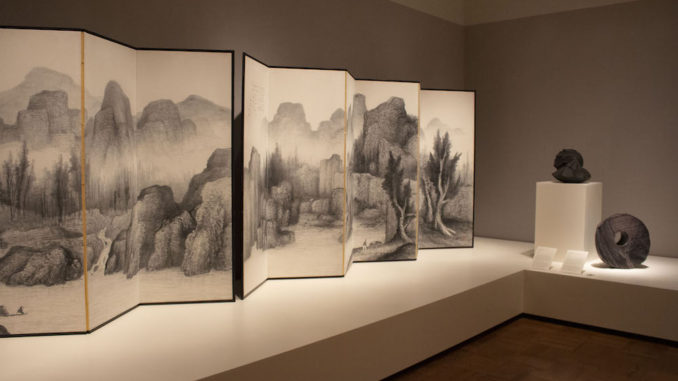
By Justin Howerton
Art and stories are intertwined entities. Famous national tales often originate from oral traditions and distinct cultural practices; a considerable amount of art is often produced in response to these stories. In Japan, this distinction between art and the stories that influence them is essentially nonexistent. Many Japanese artists have pursued the task of synthesizing visual art with literary material. Selections of Japanese works of this nature are now on display at the Portland Art Museum in the exhibit titled “Poetic Imagination in Japanese Art.” Spanning an immense period of Japanese history, this gallery seeks to unravel some of the intricacies that link Japanese calligraphy and poetry with visual art.
Many of the changes associated with Japanese art were caused by shifting dynamics in the imperial regime and court culture. One genre that developed as a result of these forces was “waka.” Employed primarily by Japanese aristocrats during the 8th century to gain influence within the royal court, waka is similar to haiku. Following the syllable standard of 5,7,5,7,7, waka poetry is often accompanied by portraits of prominent Japanese figures and a brief caption. One piece called “Akashi Bay” uses hues of pale pink, orange and blue to create a mesmerizing scene of a woman gazing across the sea. This work contained no physical characters but was inspired by a verse from the poet Kakinomoto no Hitomaro.
A larger room that houses the more modern pieces of the exhibit follows the hall of portraits paired with poetry. These specific works were influenced by Chinese artistic practices. The Chinese artistic movement known as the Literati, a unique branch of painting that developed in opposition to the more refined taste of the aristocracy, was gradually introduced into Japan through migration, trade and exploration. Emphasizing the validity of self-expression during its height in the 18th and 19th centuries, this style resonated with many painters who were unhappy with the current artistic standard. The piece “Thatched Retreat on Cold Mountain” highlights this development. Depicting a cottage nestled among arching trees and formidable cliffs, this work is characterized by a nearly translucent palette that contrasts some of the earlier portraits.
The growing instability of the shogunate during the 19th century may have played a role in the emergence of landscapes and seasons as subjects for artists. With foreigners eager to trade and political feuds dividing the country, perhaps these artists felt inspired to produce works that captured more constant features of the world. Subdued colors and intricate, deft brushstrokes illuminate the vertical paintings that line these walls.
As Japan began to modernize in the late 19th century, two distinct forms of painting emerged in response to outside influences. Using ink and pigments derived from minerals, “Nihonga” is the more traditional of the two. Relying on oil and more Western themes, “Yoga” involves subjects that are not exclusive to Japan. However, vivid colors and a heightened sense of imagination are components of both of these distinct classes. One of the most striking pieces of the exhibit contained nothing more than a single Japanese character. Created as a response to an experience during World War II, the piece titled “Shout” is the epicenter of the gallery. The artist Inoue Yuichi painted this character with massive brushstrokes in frozen black ink. This modern work echoed similar styles that I had witnessed at the beginning of the exhibit, bridging the gap between Japan’s feudal past and promising artistic future.
Subscribe to the Mossy Log Newsletter
Stay up to date with the goings-on at Lewis & Clark! Get the top stories or your favorite section delivered to your inbox whenever we release a new issue.

Leave a Reply